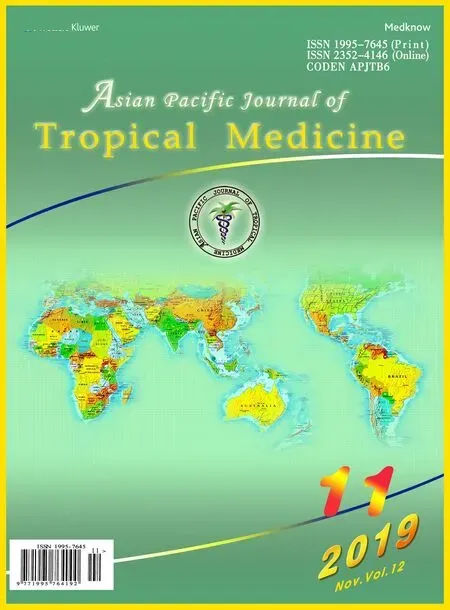Fatal cases of animal-mediated human rabies: Looking beyond sectoral prism to One Health
Folorunso Oludayo Fasina
1Emergency Centre for Transboundary Animal Diseases, Food and Agriculture Organization of the United Nations (FAO-ECTAD), Dar es Salaam, 14111, United Republic of Tanzania
2Department of Veterinary Tropical Diseases, University of Pretoria, Onderstepoort 0110, South Africa
This issue of Asian Pacific Journal of Tropical Medicine has published a case report[1]. This report detailed an atypical fatal case of fox-mediated human rabies. It once again reemphasized the importance of zoonotic disease transmission by animals (including wildlife), and a need to look introspectively in order to consider innovative solutions aimed at reducing the burden of zoonoses. Rabies continues to significantly impact human lives, particularly in the Asian and Africa regions where fatal dogmediated rabies in humans accounts for 96% of total rabiesassociated global death annually (> 59 000)[2]. In the current case, a fox (Vulpes vulpes) had attacked a man in a farm area in Qom, Iran, inflicting injuries in the head and palms. The patient only sought wound dressing without the necessary follow-up postexposure prophylaxis. Ultimately, death supervene despite all effort at late recovery[1]. This brings to focus the importance of targeted but intense community awareness campaign on rabies and other zoonoses, especially with regards to preventive and mitigation measures that can reduce zoonotic burdens in atrisk communities. Such activities have been tested with positive outcomes in Moshi, Tanzania and elsewhere[3, 4].
Although Qom is a metropolis, south of Tehran, and it is the seventh largest city in Iran with a human population of over 1.2 million, the Qom Province has four other cities. Perhaps these cities may not be predisposed to cases of wildlife associated rabies except in rare cases of stray wildlife. However, all other human habitations in the province are classified as villages. It is a fact that villages are suitable interfaces for human-wildlife-domestic animal interactions. The wild cats, hyenas, wolves, jackals, desert foxes and foxes (all potentials reservoirs for Rabies lyssavirus), are among the rich fauna of Iran, inclusive of, in the low plain of Qom[5], and these animals may likely be involved in territorialrelated human-animal and wildlife-domestic animal conflicts. Although, sources of aggression may include provocation, entering the animal protected territories, possessiveness, response to a painful injury, fear, maternal instinct, pursuant of prey, or rabies-associated aggression[3], in the current case, the cause of the fox attack was not stated. Based on reports, dog-mediated rabies had predominated in Qom and other parts of Iran, but this should not exclude the possibility of other forms of rabies transmission. The current atypical case of fox bite associated rabies puts into perspective, that other forms of rabies transmission, not dogmediated rabies, is likely to happen. This present case should elicitate more investigation on potential causes of human deaths, especially when symptoms suggestive of rabies exist, even in the absence of histories of dog bites. Perhaps, cases of atypical human rabies have been underreported in previous circumstances.
Previous work had mapped rabies at the human-dogs-wildlife interface[6], and at such interfaces, control of zoonoses are often complicated and complex. Interface communities should be targeted for intense awareness campaign, mass vaccination of domestic animals, the restriction of domestic dog-wildlife interactions, movement control of reservoir populations (wildlife) through barriers and other similar control measures[3, 6]. Where cost associated with these measures overburden the subnational government, subsidy system from the national authorities should be instituted or portions of the eco-tourism funds should be redirected at such measures.
Combating infection at source remains one of the best approach to rapidly prevent escalation of infection, effectively detect pathogens and efficiently respond to and curtail outbreak situations. Given that health service deliveries are often delayed at subnational levels (villages, wards and rural areas), these locations most times also double as interfaces where the vast majority of rabies-related morbidities and mortalities occur in Asia and Africa[2]. To achieve the objective of timely and efficient delivery of health services while at the same time utilizing cost-effective options, local public, animal and agro-environmental health authorities need to define One Health working arrangements that facilitate coordination, communication and collaborations[7]. Institutionalizing such platform at subnational levels should benefit the national health systems and reduce the burden of zoonoses.
It is established that dogs account for up to 99% of all cases of human rabies[2]; and with over 59 000 annual human deaths related directly to rabies, an associated loss of 3.7 million DALYs (disability-adjusted life-year: productivity losses due to mortality or morbidity) and an estimated annual global economic cost of dog-mediated rabies of US$ 8.6 billion (95% confidence interval, 2.9-21.5 billion)[2, 8], it is cost effective and discerning for nations to implement carefully designed effective dog and cat vaccinations annually to reduce the burden of human rabies and proceed towards elimination target set for the year 2030[3,4,8].
Conflict of interest statement
No potential conflicts of interests with respect to publication of this article.
 Asian Pacific Journal of Tropical Medicine2019年11期
Asian Pacific Journal of Tropical Medicine2019年11期
- Asian Pacific Journal of Tropical Medicine的其它文章
- Nanoemulsified Mentha piperita and Eucalyptus globulus oils exhibit enhanced repellent activities against Anopheles stephensi
- Efficacy of diurnal BG-Sentinel traps to capture nocturnal adult Armigeres subalbatus mosquitoes and impact of altitudinal variations in forests
- Molecular characterization of Echinococcus granulosus in paraffinembedded human tissues from Southwest Iran
- Influence of geographic, knowledge and behavioral factors on Opisthorchis viverrini infection in the Northeast of Thailand
- Phytopharmacological potential of the natural gift Moringa oleifera Lam and its therapeutic application: An overview
- Fatal case of human rabies infection: A case report
